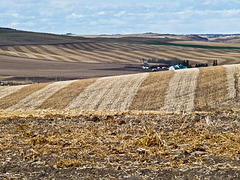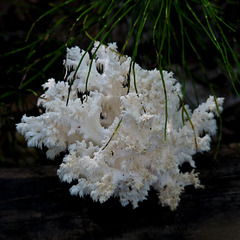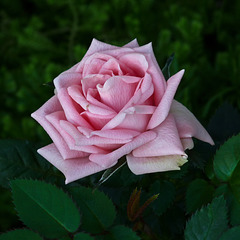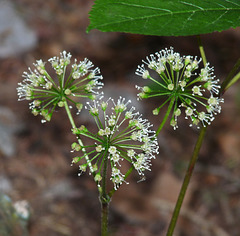Anne Elliott's photos with the keyword: DMC-FZ28
"At Risk" Swift Fox
| 07 Apr 2013 |
|
A photo of one of the small Swift Foxes at the Calgary Zoo, taken on 14 September 2009. Such beautiful creatures.
"Captive breeding of swift foxes began in 1973 through a privately run program. In 1978, the species was officially designated as "extirpated" in Canada by COSEWIC, and a national recovery plan was approved in 1995 to reintroduce swift foxes and create a self-sustaining Canadian population. The species is now (August 20th, 2003) listed as "endangered" by COSEWIC. Swift foxes were first officially released in Alberta in 1983. By 1996, 540 foxes had been released in the Alberta-Saskatchewan border and the Milk River Ridge areas, parts of the species' native range. Most animals released were bred in captivity; the remainder were wild-born animals imported from the United States. At present (August 20th 2003), it is estimated that there are approximately 96 swift foxes in Alberta, most of them the offspring of released foxes. The population is stable or increasing slightly, but the species remains extremely vulnerable because of its small numbers and limited distribution." From www.srd.gov.ab.ca/fishwildlife/escc/pdf/swift_fox.pdf
After yesterday morning's adventure in dense fog, I'm staying home today, watching the falling snow through my window. Boy, I should have posted a really bright, colourful, cheery photo today.
Bad feather day
| 03 Mar 2013 |
|
This Ostrich at the Calgary Zoo looks rather like s/he got up on the wrong side of the bed - though I guess, in reality, that is what Ostriches always look like, ha. Taken on17 October 2009, and found while trying to save a few more of my old photos this week. I really need to make a lot more space on my hard drive before spring arrives and along with it, all the upcoming botanizing photos. This is getting done ridiculously slowly.
"The ostrich shares the order Struthioniformes with the kiwis, emus, rheas, and cassowaries. It is distinctive in its appearance, with a long neck and legs, and can run at up to about 70 km/h (43 mph),[3] the fastest land speed of any bird.[4] The ostrich is the largest living species of bird and lays the largest eggs of any living bird (extinct elephant birds of Madagascar and the giant moa of New Zealand laid larger eggs).
The ostrich's diet consists mainly of plant matter, though it also eats invertebrates. It lives in nomadic groups of 5 to 50 birds. When threatened, the ostrich will either hide itself by lying flat against the ground, or run away. If cornered, it can attack with a kick of its powerful legs. Mating patterns differ by geographical region, but territorial males fight for a harem of two to seven females.
The ostrich is farmed around the world, particularly for its feathers, which are decorative and are also used as feather dusters. Its skin is used for leather products and its meat is marketed commercially." From Wikipedia.
en.wikipedia.org/wiki/Ostrich
Funny to even think about wildflowers and insects, as we are having a winter storm today, with heavy, blowing snow! Visibility is really bad, but the temperature is only -3C. Drive carefully if you HAVE to go out, everyone - me, I'm staying home : )
As the weeks fly by ..
| 18 Nov 2012 |
|
I'm finding it almost impossible to believe that Christmas is only five weeks away! Being away on a week's holiday in mid-September and now having so many summery images to go through is partly to blame, I suspect : ) Happened to come across this photo of a beautiful Christmas Cactus flower from my archives, that was taken on 10 November 2009, and thought it might help me feel in a Christmas mood. I have dozens of Christmas letters and cards that need to be done so that they can be posted overseas. I used to love doing these, but have to admit it gets harder with every passing year.
Incense burner from Oman
| 06 Mar 2012 |
|
I've had this old, crude incense holder for around 35 years, took a photo of it about two years ago and am now finally posting it : ) I tried burning a piece of Frankincense several times, but discovered that my kitchen walls were covered in tiny flecks of black afterwards, which was not good! Better to be done outdoors.
This is an interesting article from the BBC, from 9 February 2010, about Oman's Frankincense and also about the research into Frankincense and a possible cure for cancer. Also a link to the short video on YouTube, connected to the article.
""The records show that frankincense was produced here as far back as 7,000 BC."
news.bbc.co.uk/2/hi/middle_east/8505251.stm
youtu.be/42Qr6X-RhBA
Delicately dressed in pink and green
| 10 Mar 2012 |
|
An old Rose photo from my archives, taken on 25 February 2010, with my Panasonic DMC-FZ28.
Crocodile Monitor Lizard
| 23 Mar 2012 |
|
An image from my archives, taken on 4 April 2010, at the Calgary Zoo. Unfortunately, the Australia House at the Zoo has been shut down since then, as it was so badly in need of repair.
"Varanus salvadorii, first described in 1878, is the largest species of monitor lizard found in New Guinea, and is believed to be one of the longest lizards in the world, reaching up to 244 cm (8.0 ft). It is an arboreal lizard with a dark green body and yellowish bands, a blunt snout and a very long tail. It lives in mangrove swamps and coastal rain forests in the southeastern part of the island, where it feeds on birds, small mammals, eggs, and carrion in the wild, using teeth that are better adapted than those of most monitors for seizing fast-moving prey. Like all monitors it has anatomical features that enable it to breathe more easily when running than other lizards can, and V. salvadorii is thought to have greater stamina than most monitors. Little is known about its reproduction and development, as the species is very difficult to breed in captivity.
V. salvadorii is threatened by deforestation and poaching, and is protected by the CITES (Convention on International Trade of Endangered Species) agreement. The lizard is hunted and skinned alive by tribesmen to make drums, who describe the monitor as an evil spirit that "climbs trees, walks upright, breathes fire, and kills men". However they also say that it gives them warnings if there are crocodiles nearby." From Wikipedia.
Dwarf Poinciana
| 22 Mar 2012 |
|
Needed something bright and cheery today, as it is snowing. What a difference a day makes - yesterday, as seen in the image posted above, was blue skied and sunny. Photographed in the ENMAX Conservatory at the Calgary Zoo on 26 April 2010.
Happy Valentine's Day
| 13 Feb 2012 |
|
Posting a day early so that friends overseas will get my best wishes in time. Have a happy day, everyone! This is a photo from my archives, from way back on 16th October, 2009.
Stubble stripes
| 04 Mar 2012 |
|
This photo was taken somewhere just south of Highway 22X (not too far from home) on 3 April 2010. I always love the colours and patterns of the fields when they look like this. This is more or less what everywhere has been looking like for a good part of our present winter - but not today. Snow returned overnight and it looks like a winter wonderland everywhere. If only the sun could come out, too : ) I feel so lucky to live within short reach of such beautiful rolling hills.
Beautiful old barn
| 14 Jan 2012 |
|
A beautiful old barn seen on the Colpitts Ranch, Springbank, west of Calgary, on 17th September 2009. Near the end of our botanizing walk, the sky opened and down came the rain. I had intended taking all sorts of shots of this old structure when our walk was over, but this ended up being the only shot I could take, thanks to the weather.
Orange Jelly Fungus
| 14 Jan 2012 |
|
A photo taken on 15th August 2009 at the Snakes Head Natural Area on a botanizing day trip. I always enjoy coming across this orange Jelly Fungus that adds a welcome splash of bright colour deep in the forest.
Hericium sp
| 13 Jan 2012 |
|
I don't see this kind of fungus very often, but I'm always thrilled to bits when I do. Sometimes, it's in far better condition than others, this being one of the less good times. Growing on a rotting log at West Bragg Creek, Kananaskis, on 20th August 2009.
Goat's-beard
| 16 Nov 2011 |
|
This is one of our most invasive, destructive plants and it has taken over a lot of our parks and natural areas. Introduced from Eurasia. The bright yellow flower is beautiful, as is the dandelion-like seedhead, but what a huge problem it is.
en.wikipedia.org/wiki/Tragopogon_dubius
The joy of RED
| 21 Nov 2011 |
|
Not a very good photo, but I just couldn't resist a splash of red berries this morning, ha. Taken at the Calgary Zoo on 31st October 2009.
Beauty in miniature
| 20 Nov 2011 |
|
A delicate Miniature Rose that was growing in the ENMAX Conservatory at the Calgary Zoo on 18th February 2010.
Sainfoin / Onobrychis viciifolia
| 11 Sep 2011 |
|
Sainfoin has been grown in parts of Europe and Asia for hundreds of years. Various strains have been introduced to North America as a forage crop since about 1900. We came across this plant growing at Carburn Park on 23rd June 2009 - I think this is the only location in the city where it grows. Belongs to the Pea family and blooms June-August. It is considered a weed - but, as usual, a very beautiful weed.
Image used on UBC Botany Photo of the Day website, 8 April 2013.
www.botanicalgarden.ubc.ca/potd/2013/04/onobrychis-viciif...
Wild Sarsaparilla / Aralia nudicaulis
| 30 Sep 2011 |
|
This photo was taken way back on 2nd July 2009, at the Mountainview Sports and Handicapped Centre north of the city. I think I've only ever come across this plant two or three times, and it's not the easiest plant to photograph. Being posted for interest, not for photographic merit : )
"Sarsaparilla is a primary ingredient in old fashioned-style root beer, in conjunction with Sassafras, which was more widely available prior to studies of its potential health risks." From Wikipedia. Thanks, Papa Ellis!
en.wikipedia.org/wiki/Aralia_nudicaulis
Viceroy butterfly / Limenitis archippus
| 02 Oct 2011 |
|
This highly cropped image is from way back on 23rd July 2009. I was thrilled to bits to have spotted this beautiful Viceroy butterfly while we were botanizing the Nodwell Sanctuary, SE of the city. This is the only time I have ever seen this species - in fact, I had never even heard of it before. In Alberta, it is an uncommon species. I will add a previously posted image, showing the topside. Rather similar to a Monarch butterfly, but much smaller.
en.wikipedia.org/wiki/Viceroy_butterfly
Jump to top
RSS feed- Anne Elliott's latest photos with "DMC-FZ28" - Photos
- ipernity © 2007-2025
- Help & Contact
|
Club news
|
About ipernity
|
History |
ipernity Club & Prices |
Guide of good conduct
Donate | Group guidelines | Privacy policy | Terms of use | Statutes | In memoria -
Facebook
Twitter


















